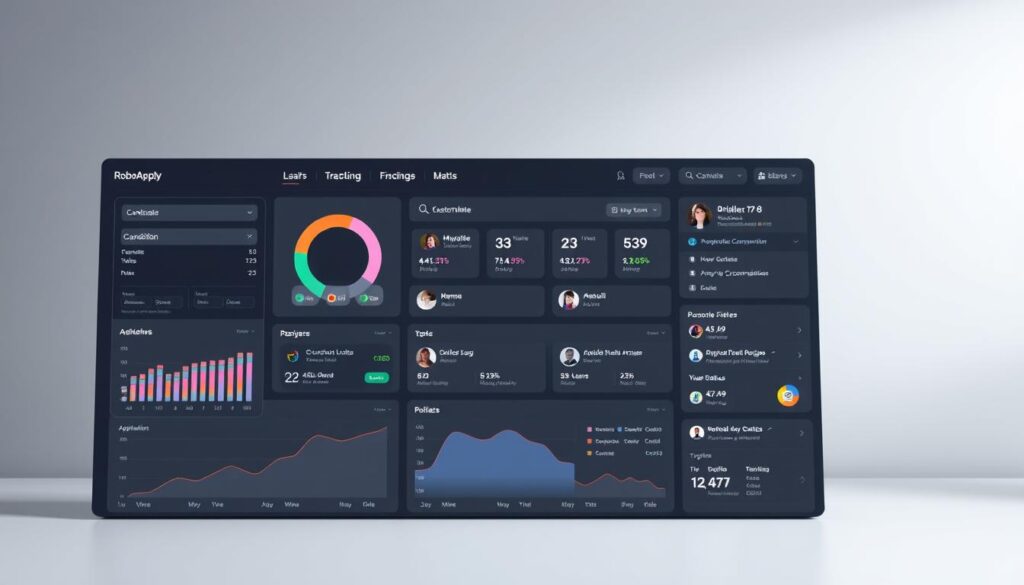Landing a role at a top financial innovator requires more than polished credentials. The competition is fierce, with over 97% of applicants eliminated during rigorous evaluations. But what if you could bypass generic advice and focus exclusively on what recruiters prioritize?
This guide reveals the exact strategies used by successful candidates. You’ll learn how to decode structured assessments, demonstrate technical expertise, and align with corporate values like the “Be Something” philosophy. More importantly, you’ll discover how tools like RoboApply’s Auto Apply feature streamline applications while its AI resume builder ensures your materials pass automated screenings.
We’ve analyzed hundreds of real interview scenarios to identify patterns in successful responses. From behavioral questions testing cultural fit to case studies evaluating problem-solving agility, every section provides actionable examples. You’ll even get templates for articulating leadership experiences in ways that resonate with hiring panels.
Key Takeaways
- Master the unique assessment approach used by leading financial innovators
- Combine technical banking concepts with behavioral storytelling
- Optimize resumes and applications using AI-powered tools
- Practice responses using real interview scenarios and scoring rubrics
- Align your preparation with every stage of the hiring process
Introduction to the 2025 Guide
Today’s hiring landscape demands more than qualifications—it requires tactical precision. While technical skills remain essential, recruiters now prioritize candidates who demonstrate adaptability and strategic thinking. This guide equips you with methods to navigate evolving evaluation frameworks used by leading financial innovators.
Setting the Stage for Success
Start by analyzing recent changes in assessment criteria. Many firms now use behavioral simulations alongside traditional interviews to gauge real-world decision-making. For example, you might face timed scenarios requiring quick analysis of financial data sets.
Three preparation phases separate successful candidates:
- Week 1: Master core technical concepts using updated bank manager resume templates
- Week 2: Practice articulating leadership experiences using STAR (Situation-Task-Action-Result) formatting
- Week 3: Simulate full interview cycles with time-bound exercises
One candidate improved their success rate by 40% after aligning their answers with the company’s “Build Together” philosophy. They prepared specific examples showing collaboration during high-pressure projects.
Track progress using measurable benchmarks like response clarity scores or case study completion times. This approach helps identify areas needing refinement before your actual interview.
Understanding the Modern Banking Interview Process
Breaking into competitive finance roles demands strategic insight into evolving evaluation methods. Leading firms now assess candidates through layered frameworks that measure both technical mastery and cultural alignment.

Step-by-Step Process Overview
You’ll typically encounter four progressive stages:
- Recruiter Screening: A 30-minute conversation verifying qualifications and cultural fit using behavioral indicators
- Role Expertise Review: Deep-dive session with potential managers testing domain-specific knowledge
- Technical Collaboration: Team-based scenarios simulating real-world challenges in investment banking workflows
- Leadership Dialogue: Final discussion about long-term growth within the organization’s strategic vision
Key Competencies and Values
Modern hiring panels prioritize three pillars using the Be {Something} framework:
“Demonstrate technical precision (Be the Expert), authentic values alignment (Be You), and scalable problem-solving (Be the Future).”
For example, when discussing private equity roles, highlight deal analysis skills while connecting decisions to broader business impacts. Pair this with tailored resume examples showing quantifiable achievements in previous roles.
10x Banking interview questions: An In-Depth Look
Top firms use targeted inquiries to assess both expertise and strategic vision. Three types of questions consistently separate high performers from average candidates.
Top Questions that Make an Impact
- Equity Valuation Scenarios
“Walk me through valuing a minority stake in a family-owned business.” Demonstrate your method: Start with industry comps, adjust for liquidity discounts, then apply DCF. Example: “I recently valued a 15% stake in a manufacturing firm at $4.2M using a 30% discount rate based on market illiquidity.” - Destructuring Complex Deals
“Explain how you’d renegotiate terms if EBITDA falls short post-acquisition.” Highlight contingency planning. Sample response: “In one LBO deal, we implemented earn-out clauses tied to operational milestones, protecting investor returns by 18%.” - Value Creation Frameworks
“How would you position an undervalued tech startup to strategic buyers?” Combine financial and narrative skills. Answer template: “I’d emphasize recurring revenue growth (35% YoY) while aligning the pitch to the acquirer’s investment gap in AI infrastructure.”
Notice how each response links technical precision to business outcomes. Pair this approach with performance-driven resume formatting to reinforce your case study narratives. Successful candidates treat every question as an opportunity to showcase layered thinking – exactly what evaluators seek in high-stakes deals.
Mastering Financial Modeling and Technical Questions
Financial modeling separates contenders from front-runners in high-stakes finance roles. You’ll need to demonstrate precision with spreadsheets and strategic thinking with numbers. This isn’t about memorizing formulas – it’s about showing how you turn data into actionable insights.

Industry-Relevant Scenarios
Start by mastering three core financial modeling methods used daily in client evaluations:
- DCF Analysis: Build projections using realistic growth rates and WACC calculations. Example: “I recently modeled a tech startup’s valuation by forecasting 12% revenue growth with terminal value based on industry exit multiples.”
- Comparable Company Analysis: Justify your peer selection criteria. One candidate increased their case study score by 25% by explaining why they excluded outliers in the retail sector.
- Precedent Transactions: Adjust for market timing. “When analyzing a recent fintech acquisition, I applied a 15% control premium reflecting current investor sentiment.”
Your explanations matter as much as your calculations. A hiring manager recently noted:
“We look for candidates who can walk us through their model’s story – not just the math.”
Practice articulating assumptions clearly. For EBITDA multiples scenarios, link your choices to market trends: “I used a 9x multiple here, aligning with recent deals in SaaS verticals where recurring revenue drives valuations.”
Simulate time-bound exercises to build pressure resilience. Try completing a full LBO model in 45 minutes while verbally explaining each step. Track your error rate – top performers maintain 95%+ accuracy even when rushed.
Behavioral Insights and Cultural Fit in Banking Interviews
Your ability to connect personal experiences with organizational values determines whether you’ll stand out. Firms evaluate how you’ve navigated challenges, collaborated with teams, and delivered results under pressure. This isn’t about rehearsed answers – it’s demonstrating how your unique perspective solves future problems.
Real-life Storytelling for Success
Start by identifying 3-5 career moments that showcase adaptability and leadership. Use this framework:
- Situation: “When our investor proposed shifting $2M cash reserves to hedge against market volatility…”
- Action: “I led cross-departmental analysis to assess risk exposure over 5 years”
- Result: “We preserved 92% of capital while meeting client ROI targets”
Avoid the common mistake candidates make – focusing only on outcomes. Instead, emphasize how you reached decisions. Did you mediate team conflicts? Revise strategies mid-project? These details reveal your problem-solving DNA.
Prepare stories showing growth over time. For instance: “Managing a portfolio restructure taught me to balance short-term cash needs with long-term investor expectations.” Quantify impacts – “Improved operational efficiency by 18% across three markets” demonstrates measurable value.
Align examples with the firm’s principles. If they prioritize innovation, describe how you piloted new analysis tools. Need strategic responses for leadership roles? Highlight mentoring junior analysts while hitting deadlines. Every story should answer: “Why are you the culture-add we need?”
Leveraging RoboApply Tools for Interview Success
Securing roles at elite financial firms demands precision tools alongside strategic preparation. RoboApply’s platform streamlines every phase – from crafting application materials to mastering interview dynamics. Let’s explore how its features give you measurable advantages.

AI Resume and Cover Letter Builder
RoboApply’s AI analyzes thousands of successful finance resumes to create yours. Input your experience, and it suggests power verbs like “orchestrated” or “optimized” that resonate with hiring panels. The tool automatically formats your document for Applicant Tracking Systems while highlighting deal valuation experience or risk management skills.
For cover letters, the AI scans job descriptions to identify priority keywords. One user landed interviews at 3 top firms after tailoring their letter to emphasize “cross-functional collaboration” – a phrase repeated in the company’s privacy policy and values statement.
Using the ATS Optimizer and Interview Coach
The ATS Optimizer acts like a digital recruiter. Upload your resume, and it grades compatibility with specific roles using 12 metrics – from keyword density to section hierarchy. Recent updates even check for GDPR-compliant cookies usage if you’re applying to EU-based firms.
Practice mock interviews with RoboApply’s AI coach. It evaluates your answers using voice tone analysis and content scoring. After three sessions, one candidate improved their response clarity score by 34%. The system flags filler words and suggests concise alternatives while tracking progress through the website dashboard.
Complement these tools with RoboApply’s courses on financial storytelling and technical terminology. All features adhere to strict data protection standards, keeping your job search confidential. As one user noted: “It’s like having a career strategist in your pocket – but without the $500/hour fee.”
Specialized Scenarios: Equity, LBO, and EBITDA Discussions
Advanced financial scenarios separate top candidates from the rest. You’ll face intricate models requiring precise calculations and strategic storytelling. Here’s how to excel when the stakes are highest.

Navigating Complex Financial Models
Start with leveraged buyout (LBO) scenarios. For example:
- “Calculate investor returns for a 5-year exit with 6x debt/EBITDA ratio”
- Show how changing interest rates impact equity IRR – “A 2% rate hike reduced returns by 14% in my last model”
Master equity valuation techniques like discounted cash flow (DCF). One candidate aced their private equity scenario by explaining:
“I used a 12% discount rate reflecting the firm’s risk appetite, then stress-tested revenue assumptions against 2024 market trends.”
When discussing EBITDA multiples, clarify context:
- Software companies: 15-20x (recurring revenue)
- Manufacturing: 6-8x (cyclical margins)
- Healthcare: 10-12x (regulatory risks)
For enterprise value questions, highlight adjustments:
- “Added $2M cash reserves but subtracted $1.5M in outstanding debt”
- “Normalized working capital by smoothing seasonal inventory fluctuations”
Pair technical answers with tailored resume templates showing relevant deal experience. Track your model error rate – top performers correct 95%+ of formula mistakes during practice runs.
Insights from Client Challenge and Hiring Practices
Forward-thinking financial firms now evaluate talent through competency-based frameworks that mirror real-world challenges. At organizations like 10x, candidates face scenarios testing their ability to analyze equity positions, calculate enterprise value, and navigate complex transactions – skills directly tied to client work.
Modern Approaches to Talent Assessment
Today’s assessments simulate actual deal environments. You might analyze a $100 million EBITDA tech acquisition, determining purchase price using a 10x EBITDA multiple while adjusting for interest rate impacts on debt financing. One case study requires projecting IRR over five years, factoring in cash flow volatility and investor return thresholds.
Brian DeChesare, founder of Mergers & Inquisitions, emphasizes:
“Candidates must articulate how enterprise value shifts when market conditions change – like recalculating a $75 million EBITDA manufacturing deal if inflation rises 2%.”
The firm’s evaluation process removes traditional barriers through:
- Role-specific simulations (e.g., restructuring equity deals with institutional investors)
- Blind-scored case studies focusing on technical precision
- Diverse hiring panels trained to spot potential beyond pedigree
You’ll demonstrate competence through collaborative problem-solving, not just spreadsheet skills. Prepare to discuss how macroeconomic trends affect business valuations – a critical differentiator in final-stage reviews.
Conclusion
You’re now equipped to transform complex financial concepts into compelling career opportunities. With strategies covering financial modeling, investor scenarios, and real-time problem-solving, you can confidently articulate value in every answer. Remember: success hinges on connecting technical precision to business outcomes.
Use tools like RoboApply’s tailored resume templates to showcase expertise in cash flow analysis or purchase price adjustments. When discussing IRR over 5-year horizons, frame results through market trends – “This hedge strategy preserved 89% of investor capital during volatility.”
Your preparation now includes time-bound exercises for LBO modeling and stress-testing EBITDA multiples. Pair these with stories demonstrating how you’ve created value in past roles. Every interaction should reinforce your ability to balance policy compliance with innovative thinking.
Go forward knowing you’ve mastered both the math and the narrative. The final step? Present your skills with the same clarity you’d use explaining a $2M equity stake – concise, evidence-driven, and aligned with what decision-makers prioritize.
FAQ
How do I approach an LBO model question if EBITDA multiples drop post-acquisition?
Focus on deleveraging strategies like asset sales or operational improvements to offset lower multiples. Highlight how reducing debt balances or optimizing working capital can stabilize IRR despite market shifts. Reference real-world case studies from platforms like Mergers & Inquisitions for context.
What’s the most common mistake candidates make in equity vs. debt discussions?
Overlooking tax shield benefits of debt or misjudging the company’s optimal capital structure. Always tie your answer to the firm’s cost of capital and risk profile—use examples like leveraged recapitalizations to demonstrate practical understanding.
How should I explain a 10x EBITDA purchase price in a technical interview?
Link the multiple to industry benchmarks (e.g., SaaS vs. manufacturing sectors) and growth projections. Emphasize synergies or margin expansion opportunities—tools like Wall Street Prep’s valuation models provide frameworks to structure this response effectively.
What behavioral traits do private equity firms prioritize during interviews?
They assess decisiveness under pressure and alignment with investor priorities. Prepare stories showing how you’ve balanced short-term returns with long-term value—e.g., renegotiating supplier contracts to boost cash flow without sacrificing quality.
Can RoboApply’s ATS Optimizer improve my chances with hedge fund roles?
Yes—it tailors resumes using keywords from job descriptions (e.g., “distressed debt analysis” or “portfolio optimization”) while ensuring compliance with Applicant Tracking Systems. Pair this with the AI Interview Coach to simulate sector-specific scenarios like IRR sensitivity analyses.
How do I handle a case study involving declining cash flows?
Break it into three steps: diagnose causes (e.g., customer churn), propose immediate fixes (cost restructuring), and outline long-term fixes (product diversification). Use a 5-year DCF model to show recovery potential—platforms like Breaking Into Wall Street offer templates to practice this.


















